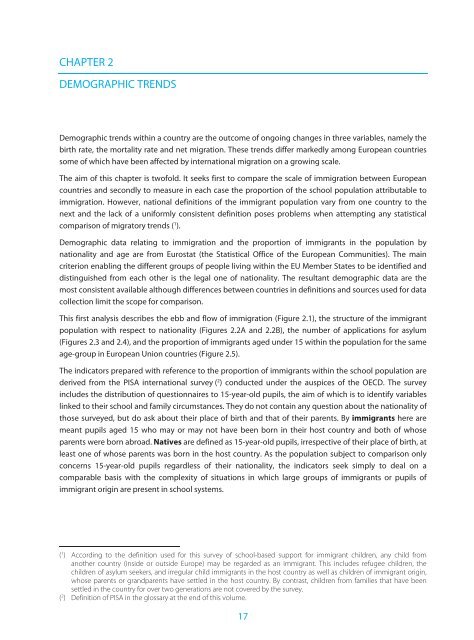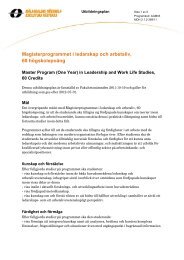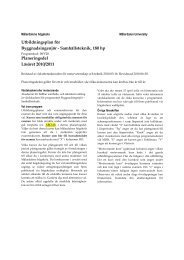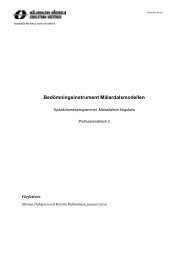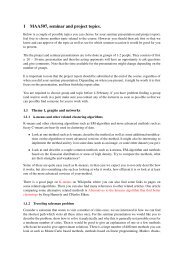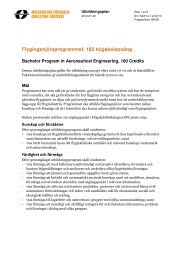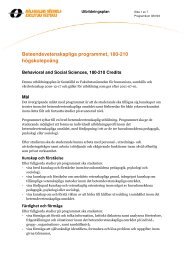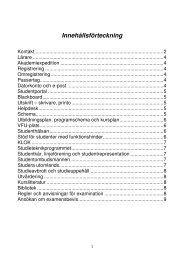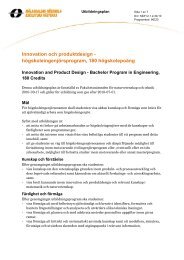CHAPTER 2DEMOGRAPHIC TRENDSDemographic trends with<strong>in</strong> a country are the outcome of ongo<strong>in</strong>g changes <strong>in</strong> three variables, namely thebirth rate, the mortality rate and net migration. These trends differ markedly among <strong>Europe</strong>an countriessome of which have been affected by <strong>in</strong>ternational migration on a grow<strong>in</strong>g scale.The aim of this chapter is twofold. It seeks first to compare the scale of immigration between <strong>Europe</strong>ancountries and secondly to measure <strong>in</strong> each case the proportion of the school population attributable toimmigration. However, national def<strong>in</strong>itions of the immigrant population vary from one country to thenext and the lack of a uniformly consistent def<strong>in</strong>ition poses problems when attempt<strong>in</strong>g any statisticalcomparison of migratory trends ( 1 ).Demographic data relat<strong>in</strong>g to immigration and the proportion of immigrants <strong>in</strong> the population bynationality and age are from Eurostat (the Statistical Office of the <strong>Europe</strong>an Communities). The ma<strong>in</strong>criterion enabl<strong>in</strong>g the different groups of people liv<strong>in</strong>g with<strong>in</strong> the EU Member States to be identified anddist<strong>in</strong>guished from each other is the legal one of nationality. The resultant demographic data are themost consistent available although differences between countries <strong>in</strong> def<strong>in</strong>itions and sources used for datacollection limit the scope for comparison.This first analysis describes the ebb and flow of immigration (Figure 2.1), the structure of the immigrantpopulation with respect to nationality (Figures 2.2A and 2.2B), the number of applications for asylum(Figures 2.3 and 2.4), and the proportion of immigrants aged under 15 with<strong>in</strong> the population for the sameage-group <strong>in</strong> <strong>Europe</strong>an Union countries (Figure 2.5).The <strong>in</strong>dicators prepared with reference to the proportion of immigrants with<strong>in</strong> the school population arederived from the PISA <strong>in</strong>ternational survey ( 2 ) conducted under the auspices of the OECD. The survey<strong>in</strong>cludes the distribution of questionnaires to 15-year-old pupils, the aim of which is to identify variablesl<strong>in</strong>ked to their school and family circumstances. They do not conta<strong>in</strong> any question about the nationality ofthose surveyed, but do ask about their place of birth and that of their parents. By immigrants here aremeant pupils aged 15 who may or may not have been born <strong>in</strong> their host country and both of whoseparents were born abroad. Natives are def<strong>in</strong>ed as 15-year-old pupils, irrespective of their place of birth, atleast one of whose parents was born <strong>in</strong> the host country. As the population subject to comparison onlyconcerns 15-year-old pupils regardless of their nationality, the <strong>in</strong>dicators seek simply to deal on acomparable basis with the complexity of situations <strong>in</strong> which large groups of immigrants or pupils ofimmigrant orig<strong>in</strong> are present <strong>in</strong> school systems.( 1 ) Accord<strong>in</strong>g to the def<strong>in</strong>ition used for this survey of school-based support for immigrant children, any child fromanother country (<strong>in</strong>side or outside <strong>Europe</strong>) may be regarded as an immigrant. This <strong>in</strong>cludes refugee children, thechildren of asylum seekers, and irregular child immigrants <strong>in</strong> the host country as well as children of immigrant orig<strong>in</strong>,whose parents or grandparents have settled <strong>in</strong> the host country. By contrast, children from families that have beensettled <strong>in</strong> the country for over two generations are not covered by the survey.( 2 ) Def<strong>in</strong>ition of PISA <strong>in</strong> the glossary at the end of this volume.17
<strong>Integrat<strong>in</strong>g</strong> <strong>Immigrant</strong> <strong>Children</strong> <strong><strong>in</strong>to</strong> <strong>Schools</strong> <strong>in</strong> <strong>Europe</strong>In this second analysis, immigrant pupils are considered <strong>in</strong> terms of the location of the schools theyattend (Figure 2.7), the level at which they are present <strong>in</strong> schools (Figure 2.8) and the language they use athome with their families (Figure 2.9).2.1. Immigration Trends over the last 25 YearsIn the period between 1985 and 2001, trends <strong>in</strong> immigration to the various countries of the <strong>Europe</strong>anUnion differed markedly. Figure 2.1, which illustrates these immigrant flows <strong>in</strong> relation to the totalpopulation <strong>in</strong> five-year <strong>in</strong>tervals over the total period, shows that countries may be classified <strong><strong>in</strong>to</strong> threema<strong>in</strong> categories <strong>in</strong> accordance with the trends observed.With<strong>in</strong> the last 20 years, four countries have experienced immigration flows correspond<strong>in</strong>g to over 1.5 %of the total population for several consecutive years, namely Germany, Cyprus, Luxembourg and Iceland.Dur<strong>in</strong>g this period, Luxembourg has experienced the highest susta<strong>in</strong>ed <strong>in</strong>flow of immigrants with respectto the total population (over 2 % annually). These flows satisfied requirements l<strong>in</strong>ked to its demographicdeficit as well as to the labour shortage result<strong>in</strong>g from its strong economic growth. Immigration toIceland has <strong>in</strong>creased <strong>in</strong> the last six years and the orig<strong>in</strong> of immigrants has changed: an <strong>in</strong>flow of Nordiccountry nationals has partly given way to immigration from eastern <strong>Europe</strong> (Poland and Lithuania) andfrom Asia (the Philipp<strong>in</strong>es and Thailand). After experienc<strong>in</strong>g immigration on a considerable scale <strong>in</strong> theyears immediately follow<strong>in</strong>g reunification and the political open<strong>in</strong>g up of the eastern <strong>Europe</strong>an countries,Germany has recorded a constant decrease <strong>in</strong> immigration <strong><strong>in</strong>to</strong> the total population s<strong>in</strong>ce 1992. However,these flows still represented 1 % of the total population <strong>in</strong> 2001.The situation is less strik<strong>in</strong>g <strong>in</strong> a second category of countries which have experienced annualimmigration of between 0.5 % and less than 1.5 % of the total population (Belgium, Denmark, France,Ireland, the Netherlands, Austria, Sweden, the United K<strong>in</strong>gdom and Norway). Among these countries,Belgium, France, the Netherlands and the United K<strong>in</strong>gdom have a long history of immigration l<strong>in</strong>ked totheir colonial past, their <strong>in</strong>dustrial characteristics or both. These countries rema<strong>in</strong> attractive as a result ofthe privileged relations they have reta<strong>in</strong>ed with their former colonies, the tendency for families to sticktogether and the establishment of <strong>in</strong>formal reception networks developed through past migrations.Countries such as Ireland and Norway have experienced an upsurge <strong>in</strong> immigration s<strong>in</strong>ce the 1990s and1980s respectively, <strong>in</strong> the wake of their economic growth.Explanatory note (Figure 2.1)This <strong>in</strong>dicator has been calculated by divid<strong>in</strong>g the number of immigrant arrivals dur<strong>in</strong>g reference year (X) by the totalpopulation on 1 January of the year (X). Detailed data for each year <strong>in</strong> the period are available on the CD-ROMannexed to the Eurostat publication (2002).The immigrants are either non-nationals who have arrived from abroad, or nationals return<strong>in</strong>g from abroad who<strong>in</strong>tend to be resident <strong>in</strong> the country for a certa<strong>in</strong> period. This period, which ranges from one month <strong>in</strong> the case of aDutch person return<strong>in</strong>g to the Netherlands, to 12 months for anyone enter<strong>in</strong>g the United K<strong>in</strong>gdom, is determ<strong>in</strong>ed bythe appropriate authorities <strong>in</strong> each country.The population on 1 January corresponds to all <strong>in</strong>habitants with<strong>in</strong> a given area on 1 January <strong>in</strong> the calendar year (or<strong>in</strong> certa<strong>in</strong> cases, on 31 December of the previous year). This population is based either on data obta<strong>in</strong>ed dur<strong>in</strong>g themost recent census, which have been corrected by data on the components of population growth s<strong>in</strong>ce that census,or on population registers.18


